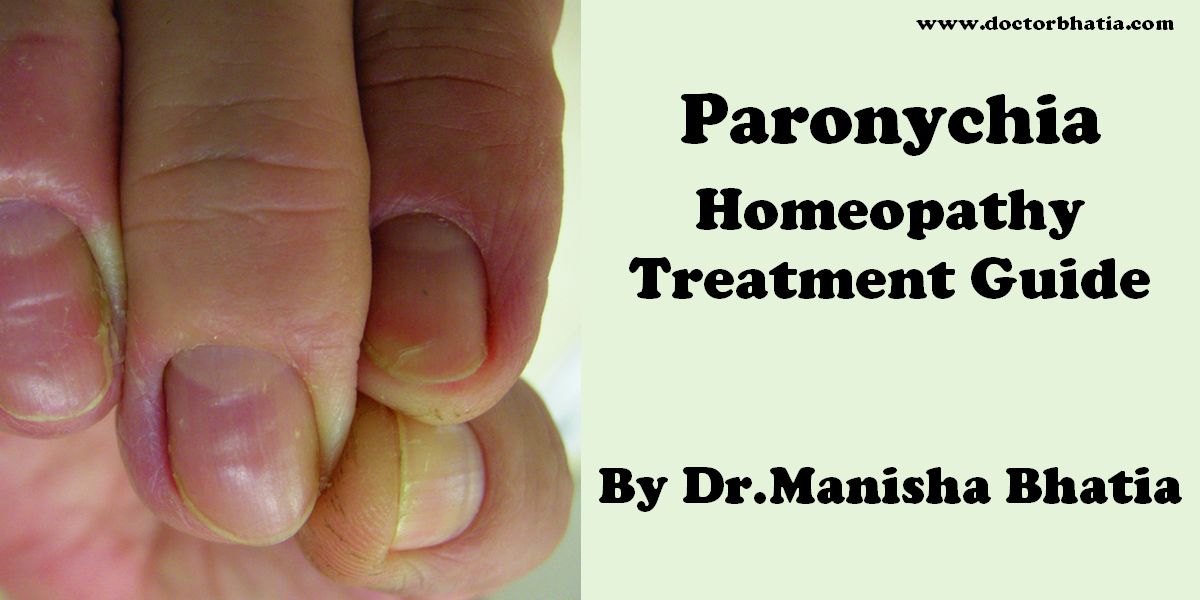The nail disease paronychia (commonly misidentified as a synonym for felon or whitlow, the latter two of which refer to a deep space infection of the distal end of a digit) is an often tender bacterial or fungal hand infection where the nail and skin meet at the side or the base of a finger or toenail. It can start suddenly (acute paronychia) or gradually (chronic paronychia).
Description
Dr. Rob Hicks writes on the BBC website:
The cuticle acts as a protective seal but if it’s damaged in any way bacteria can enter the skin and cause infection. These infections can be extremely painful as the skin becomes inflamed, hot, red and throbs continually.[1]
Pus is usually present, along with gradual thickening and browning discoloration of the nail plate.
Hicks continues:
If a large amount of pus has collected, then it may be necessary to make a small cut in the skin (sometimes under local anaesthetic) to release it.[1][2]
Acute paronychia is usually caused by bacteria. This is often treated with antibiotics, sometimes as a cream, other times orally. Chronic paronychia is most often caused by a yeast infection of the soft tissues around the nail but can also be traced to a bacterial infection. If the infection goes on and on then a fungal infection is often the cause and this needs anti-fungal cream or paint to treat it.[1]
Hicks writes further about the causes:
Whitlows are common, especially for people who have to repeatedly wash their hands. Excess water weakens the seal, while soaps and detergents remove the protective skin oils leaving the skin dry and more liable to split. Most often, trauma to the cuticle allows infection in. Biting or picking at the cuticle, damage through work and overenthusiastic manicuring are the usual culprits. If someone has a cold sore and puts their finger in their mouth then a herpes infection whitlow may appear.[1]
Individuals who work with their hands in water, such as health care workers and food processors, are quite prone to the fungal type of infection.
Herpes whitlows are frequently found among dentists and dental hygienists.[3] Prosector’s paronychia is a primary inoculation of tuberculosis of the skin and nails, named after its association with prosectors, who prepare specimens for dissection. Paronychia around the entire nail is sometimes referred to as runaround paronychia.
Painful paronychia in association with a scaly, erathematous, keratotic rash (papules and plaques) of the ears, nose, fingers, and toes, may be indicative of acrokeratosis paraneoplastica, which is associated with squameous cell carcinoma of the larynx.[4]
Homeopathy Treatment for Paronychia
Keywords: homeopathy, homeopathic, treatment, cure, remedy, remedies, medicine
Homeopathy treats the person as a whole. It means that homeopathic treatment focuses on the patient as a person, as well as his pathological condition. The homeopathic medicines are selected after a full individualizing examination and case-analysis, which includes the medical history of the patient, physical and mental constitution, family history, presenting symptoms, underlying pathology, possible causative factors etc. A miasmatic tendency (predisposition/susceptibility) is also often taken into account for the treatment of chronic conditions. A homeopathy doctor tries to treat more than just the presenting symptoms. The focus is usually on what caused the disease condition? Why ‘this patient’ is sick ‘this way’. The disease diagnosis is important but in homeopathy, the cause of disease is not just probed to the level of bacteria and viruses. Other factors like mental, emotional and physical stress that could predispose a person to illness are also looked for. No a days, even modern medicine also considers a large number of diseases as psychosomatic. The correct homeopathy remedy tries to correct this disease predisposition. The focus is not on curing the disease but to cure the person who is sick, to restore the health. If a disease pathology is not very advanced, homeopathy remedies do give a hope for cure but even in incurable cases, the quality of life can be greatly improved with homeopathic medicines.
The homeopathic remedies (medicines) given below indicate the therapeutic affinity but this is not a complete and definite guide to the homeopathy treatment of this condition. The symptoms listed against each homeopathic remedy may not be directly related to this disease because in homeopathy general symptoms and constitutional indications are also taken into account for selecting a remedy. To study any of the following remedies in more detail, please visit the Materia Medica section at Hpathy.
None of these medicines should be taken without professional advice and guidance.
Homeopathy Remedies for Paronychia :
All-c., alum., am-c., am-m., anac., anthr., apis., arn., asaf., bar-c., benz-ac., berb., bov., bufo., calc., caust., chin., cist., con., cur., dios., eug., ferr., fl-ac., gins., hep., hyper., iod., iris., kali-c., kalm., lach., led., lyc., merc., nat-c., nat-h., nat-m., nat-s., nit-ac., par., petr., phyt., plb., puls., rhus-t., sang., sep., sil., sulph., tarent-c., teucr.
References
- ^ a b c d “Doctor’s advice Q: Whitlow (paronychia)“. bbc.co.uk. Retrieved on 2008-05-10.
- ^ Jacobs, J.R. (2006 June-July). “Pathophysiology and Management of Paronychia“. collegehealth-e.
- ^ Lewis, M.A. (April 2004). “Herpes simplex virus: an occupational hazard in dentistry“. International Dental Journal 54 (2): 103–111. doi:10.2956/indj.2004.54.2.103 (inactive 2008-06-23).
- ^ Karen Allen, MD (2005-08-17). “eMedicine – Acrokeratosis Neoplastica“.



